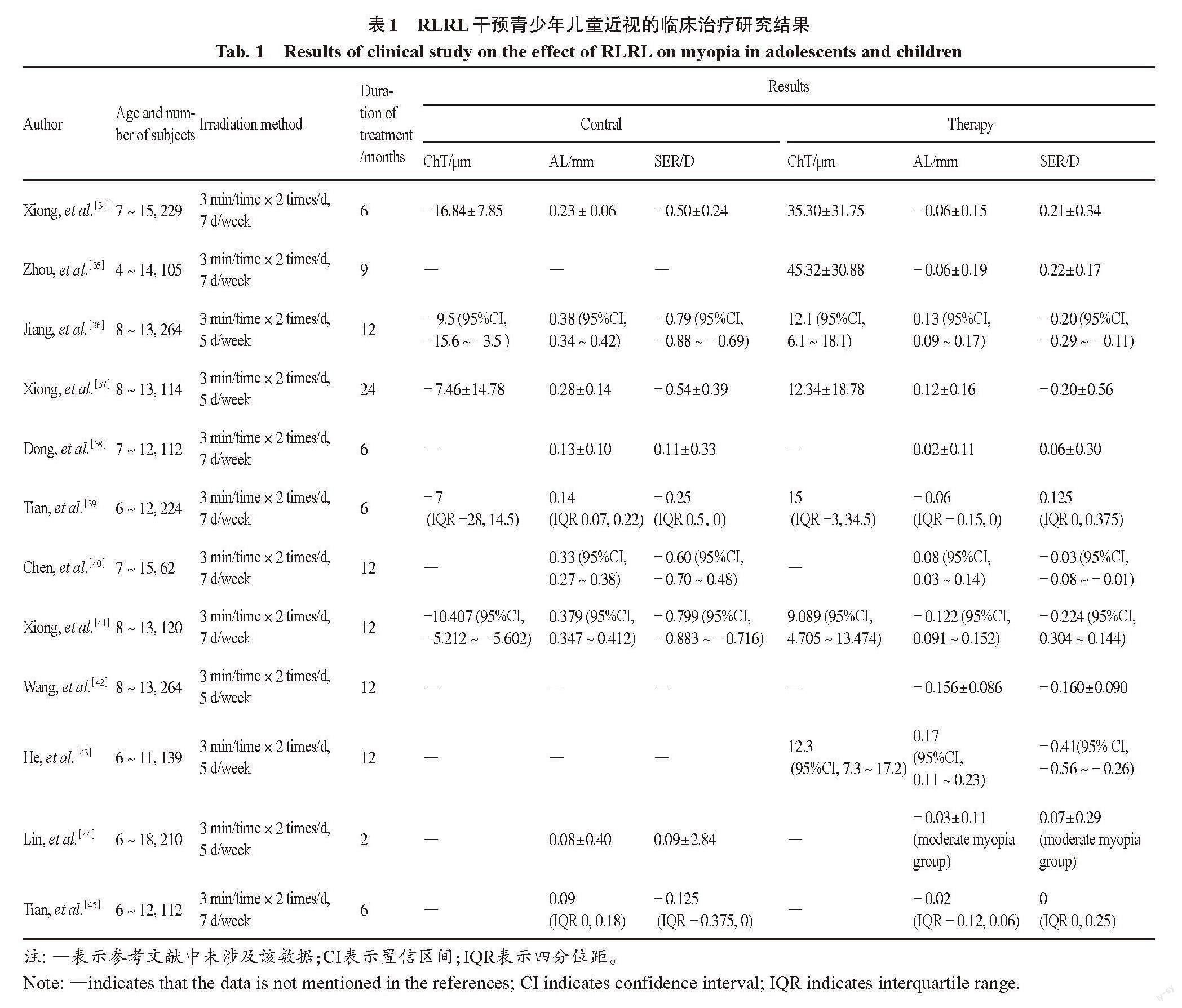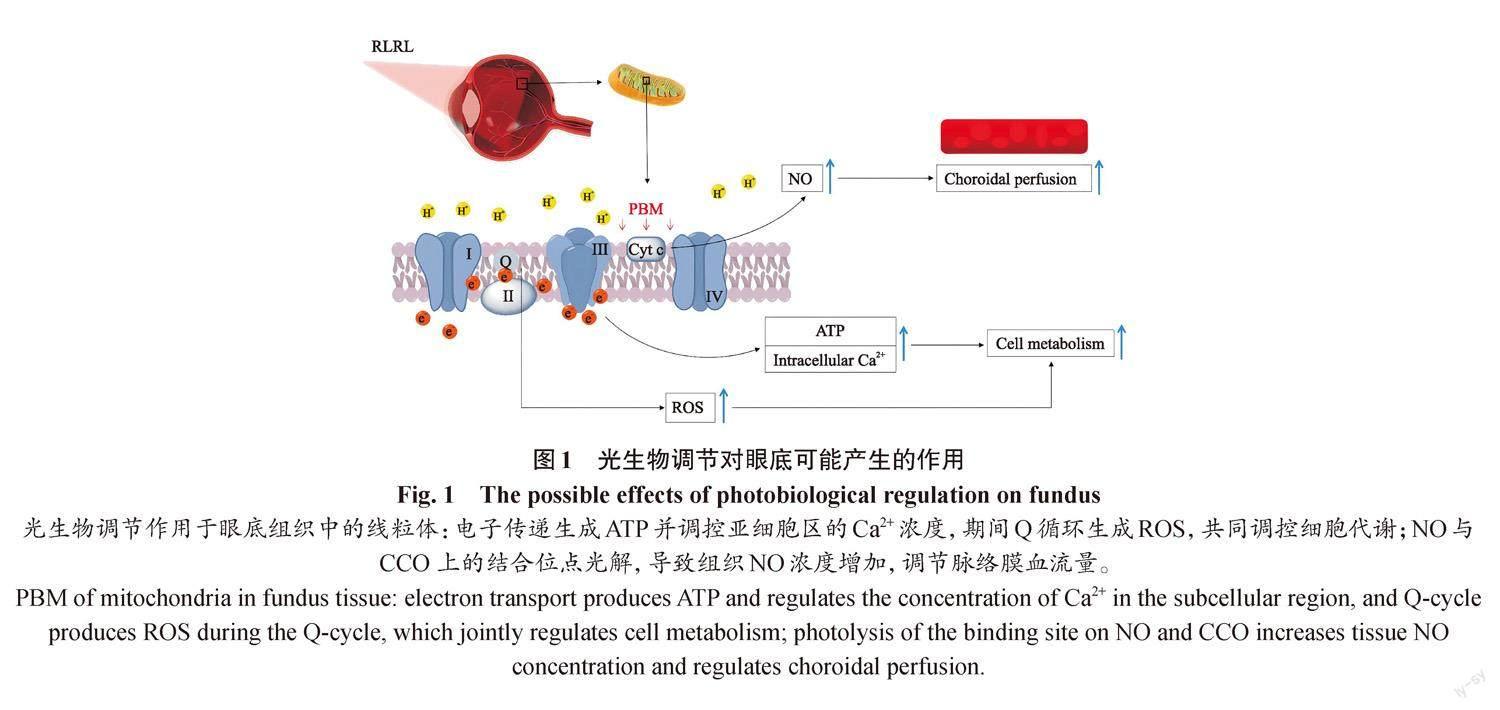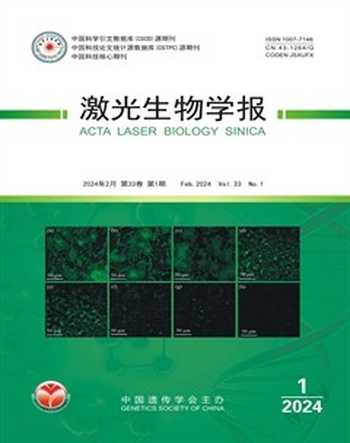重复低能量红光干预改善青少年近视的研究现状


收稿日期:2023-07-24;修回日期:2023-10-07。
通信作者:康宏向,副研究员,主要从事激光生物学效应的研究。E-mail: khx007@163.com。
刘智搏 马琼 李卉 康宏向
摘 要:近视作为眼科最常见的疾病已经发展成一项严重的国际化公共健康负担,发展形势不容乐观,有必要提出新的有效的干预措施,以遏制近视流行的浪潮。近几年,红光干预延缓近视进展成为新的研究热点。本文从近视的流行现状、近视的诱因入手,简要介绍目前临床常用治疗手段,总结红光干预近视的研究现状,讨论红光干预改善近视可能的机制机理,并提出一些潜在的激光安全问题,希望能够对未来的相关研究提供参考。
关键词:近视;红光;光生物调节;安全性;青少年
中图分类号:R779.7 文献标志码:ADOI:10.3969/j.issn.1007-7146.2024.01.003
Repeated Low-level Red-light Intervention to Improve the Research Status of Adolescent Myopia
LIU Zhibo1, MA Qiong1, LI Hui2, KANG Hongxiang1*
(1. Institute of Radiation Medicine, Academy of Military Medical Science, Beijing 100850, China;2. Beijing Childrens Hospital, Capital Medical University, Beijing 100045, China)
Abstract: Myopia, as the most common disease in ophthalmology, has developed into a serious international public health burden, the development situation is not optimistic. It is necessary to put forward new and effective intervention measures to curb the prevalence of myopia. In recent years, red light intervention to delay the progress of myopia has become a new research hotspot. Starting with the epidemic situation and inducement of myopia, this paper briefly introduces the commonly used clinical treatment methods, summarizes the research status of red light intervention in myopia, and discusses the possible mechanism of red light intervention in improving myopia. Some potential laser safety problems are put forward, hoping to provide reference for related research in the future.
Key words: myopia; red light; photobiological regulation; security; adolescence
(Acta Laser Biology Sinica, 2024, 33(1): 024-030)
进入眼睛的平行光在视网膜前聚焦引起视力模糊的屈光不正现象称为近视(myopia)。近视在青少年时期会持续发展,并伴随着患者的日常工作生活,造成的健康负担除了与光学矫正屈光不正有关的直接成本,还包括与视力损害有关的社会经济影响和生活质量下降[1],产生的危害不可估量。如近视进展可能会引起青光眼、白内障、视网膜脱离、黄斑变性等并发症[2-4],甚至存在致盲风险。因此,近视的防控与治疗是患者与医生关心的焦点。近视的主要特征包括轴向伸长和脉络膜显著变薄缺血等[5]。最新研究显示,重复低能量红光(repeated low-level red-light,RLRL)干预下近视进展状况能够得到改善,有望成为一种新的防控近视的手段。
1 疾病流行现状
1.1 近视流行现状
Holden等[6]预计,未来50年东亚近视患病人群,包括高度近视人群,将大幅度增长,全球近视患病率将高达50%。值得关注的是,东亚国家的儿童和青少年近视患病率最高[7-8],在东亞约95%的近视人群需要通过佩戴光学镜片来获得清晰的矫正视力[9]。Grzybowski等[10]的报告指出了不同地区的近视患病率,亚洲近视患病率约为60%,明显高于欧洲约40%的患病率,北美近视患病率约为42%,东亚学龄儿童的近视患病率约为73%,仅非洲和南美儿童的近视患病率低于10%。总而言之,不仅东亚地区,近视的国际发展形势均不容乐观。虽然,目前临床有针对性的治疗手段,但是仅仅靠治疗来减轻近视负担是非常困难的,急需有效的防控手段,以防止近视发病和减缓近视进展[11]。其中,预防儿童和青少年近视发生并减缓其发展是重中之重[12-15]。
1.2 近视治疗
1.2.1 近视的影响因素
关于近视形成的原因,大多数学者认为,近视与多种因素有关,除地域及种族因素外,还包括遗传因素[16]与环境因素。屈光不正与近视的遗传学全基因组关联研究能够帮助了解近视与遗传之间复杂的相互作用,并制定可能的预防和治疗措施以对抗近视流行。对于环境因素来讲,有研究表明,近视会受到空气污染物的影响,空气污染物浓度与近视的发展密切相关[17-19]。这提示,个人尽量不要或减少暴露在可预防的风险中,以防止近视的发生和发展。除此之外,大量研究表明,长时间的户外活动能够有效降低近视患病率[20],反之,户外时间不足会导致近视发生以及近视进展加快[21]。例如,中小学生由于在新型冠状病毒感染期间长时间使用屏幕进行学习和娱乐,导致近视进展加快[22]。
1.2.2 临床治疗手段
近视是屈光力和眼轴长度(axial length,AL)不匹配造成的结果[23],导致物体的图像被聚焦到视网膜前面。临床医生通过采用一些特殊手段尝试使成像的位置后移达到矫正视力的目的,除常用的佩戴框架镜之外,其他矫正方式主要包括有佩戴角膜塑形镜(即OK镜)、激光角膜削切手术和人工晶体(implantable collamer lens,ICL)植入术等。佩戴角膜塑形镜属于一种可逆性非手术的物理矫形治疗方法[24],通过逆几何设计的镜片形成中央的下压力以及旁周边的外拉力,能有效地改變角膜形态,降低中央角膜前表面曲率,从而达到矫正视力的目的。数字化角膜塑形镜作为近几年提出的新技术,是基于全角膜数据进行数字化设计的新一代全吻合角膜再成形镜,与传统角膜塑形镜相比具有长期佩戴安全有效、视觉稳定性好、可预测性和可逆性强等优点[25]。中高度成年近视患者多采用激光角膜削切手术矫正视力[26],利用激光作用于角膜,汽化一定厚度的角膜基质层组织,改变角膜的曲率,从而达到矫正屈光不正的目的,但该手术不适用于部分角膜较薄的患者。而ICL植入手术[27]适用人群广泛,可用于矫正较大度数范围的近视、远视和散光。另外,低浓度阿托品是常用的药物干预手段[28],作为M受体阻断剂麻痹睫状肌,同时通过拮抗视网膜和脉络膜上M受体抑制眼轴的增长,延缓近视发展。角膜塑形镜与低浓度阿托品单独或联合应用均适用于近视发展初期度数较低的青少年患者[29-30],但停止使用后近视的视力状况会出现反弹现象。
2 红光与近视防控
最新研究结果显示,650 nm波长的红光作用于青少年近视患者眼部,能够改善脉络膜厚度(choroicl thickness,ChT)、减缓AL与屈光度变化进展[31-33],从而改善视力并延缓近视发展。本文通过检索PubMed、Web of Science、CNKI筛选试验研究类文献,以发表时间为顺序总结RLRL干预改善近视的最新临床研究进展,旨在阐述RLRL在改善青少年近视发展中的应用,对激光干预方式、近视治疗效果、可能的影响因素与机制机理及潜在的激光安全问题进行系统总结,展望其临床应用前景,为下一步研究与实践提供指导与参考。其中,近视治疗效果即视力改善情况,通过对比试验条件与试验结果进一步阐述。
2.1 红光干预方式及其疗效
近两年发表的针对红光干预近视研究论文[34-45]的结果如表1所示,使用的光源均为波长为650 nm的半导体激光器。参与试验的患者被要求每天治疗2次、每次3 min,且2次之间相隔时间4 h以上。其中,Xiong等[34]、Tian等[39,45]临床治疗研究使用的是近弱视治疗仪(同仁医院生产),而其余研究使用的是弱视台式治疗仪(苏州宣佳光电科技有限公司生产)。研究结果显示,RLRL干预有效改善了ChT,减缓了AL与等效球镜屈光度(spherical equivalent refraction,SER)的增长。
Xiong等[34]为期6个月和Zhou等[35]为期9个月的临床治疗研究发现,RLRL治疗组患者的ChT显著增加,出现AL缩短和SER改善现象;Xiong等[37]为期24个月的临床治疗结果发现,与对照组相比,RLRL治疗组患者的ChT明显增加,AL和SER增长减缓。以上研究对比发现,RLRL持续治疗时间对ChT、AL和SER参数变化存在影响。Jiang等[36]、He等[43]试验中患者进行了为期12个月每周5 d的 RLRL治疗,治疗组患者的ChT、AL和SER 3组参数分别为:12.1 μm、0.13 mm、-0.20 D和12.3 μm、0.17 mm、-0.41 D。2项试验参数变化显示出较高的一致性,前者ChT、AL和SER 3组参数变化均优于对照组,表现出明确地延缓近视进展的治疗作用。同样,Tian等[45]、Lin等[44]和Dong等[38]的临床试验也发现了AL缩短和SER改善的治疗作用。Chen等[40]的试验中RLRL治疗组患者采用为期12个月每周7 d的治疗方法,结果显示,AL和SER分别为0.08 mm、-0.03 D。对比Chen等[40]与Jiang等[36]的2项试验发现,在为期12个月的RLRL干预条件下,每周7 d的RLRL治疗效果好于每周5 d,提示不间断地持续使用RLRL干预近视效果较好。Xiong等[37]进行的周期约24个月的红光干预近视疗效和安全性评估,包括停止干预后的潜在反弹效应,治疗组结果显示,AL和SER分别为0.16 mm、-0.31 D,与周期为12个月的结果相比(AL和SER分别为-0.01 mm、
-0.19 D)AL与屈光度均略有增长。同团队的Wang等[42]的研究结果显示,治疗1个月时观察到最大的AL相对缩短值,之后AL缩短的程度逐渐减小,AL的变化保持在稳定的水平。这些数据表明,干预引起的AL变化有可能维持在一定的水平,AL长度趋于稳定水平后便不再随着时间的推移增加,探索RLRL治疗的长期有效性至关重要。
2.2 影响因素
红光干预改善近视效果主要存在以下3个方面的影响因素:1)治疗依从性,患者良好的依从性是治疗延续性及试验结果的保证;2)每周干预天数以及总的干预周期,相关参数的变化会随着干预时间延长而趋于平稳状态;3)年龄与性别,年龄越小、近视程度越高的患者AL缩短幅度越大,另外性别差异表现为女性经历AL缩短的频率更高(在临界点上有统计学意义),根据个体差异定制干预方案也是必要的。
2.3 可能的机制机理
目前,红光干预改善近视的相关研究处于初步阶段,并不能将其改善近视进展的机制机理解释清楚。研究表明,光生物调节(photobiomodulation,PBM)在老年性黄斑变性、视网膜病变、弱视等多种视网膜疾病的治疗中都发挥着积极的作用[46-48],所以PBM可以作为探究红光干预近视治疗的研究方向。
通过研究红外/近红外光(infrared ray/near infrared ray,FR/NIR)辐射下细胞产生的各种反应,发现细胞能够吸收600~1 000 nm波长范围内单色光的光子能量,以非破坏性和非热的方式影响细胞信号转导过程[49],即PBM作用下的“光信号传导”过程,其中由线粒体触发传递至细胞核的信号被称为“线粒体逆行信号”[50]。目前,FR/NIR普遍被认为能够与线粒体内膜上的细胞色素C(cytochrome C,Cyt c)中的生色团相互作用,增加膜上复合体I、II、III、IV的活性,同时存在活性氧(reactive oxygen species,ROS)的生成、Ca2+流量的变化以及一氧化氮(nitric oxide,NO)与细胞色素C氧化酶(cytochrome C oxidase,CCO)的结合[51]。这些信号分子均参与介导线粒体逆行信号[52]。线粒体呼吸链产生能量,以膜电位的形式储存起来,形成膜电位梯度,驱动三磷酸腺苷(adenosine triphosphate,ATP)的合成,同时能够调控Ca2+在亚细胞区的局部浓度,进而激活不同的生化过程。CCO被认为是PBM的光受体[53]。NO通过与CCO直接结合来调节线粒体的呼吸,影响O2的消耗与呼吸链的氧化还原状态,低水平的NO可以在不影响ATP合成的情况下调节线粒体ROS的生成。线粒体产生的ROS主要是超氧阴离子(O2-),其主要来源是呼吸链复合体III在电子传递链Q循环过程中形成的泛半醌自由基中间体(QH·)。当FR/NIR 介入时, CCO的氧化还原状态改变,表现为ROS产生增加,同时NO与 CCO 上的结合位点光解,增强 CCO 的活性[54],促进释放的NO扩散到细胞质中。NO和ROS可以由不同的酶或相同的酶通过交替的还原和氧化过程产生,在PBM作用中NO和ROS扮演着重要角色。ROS是细胞生长和转录因子激活的重要信号分子,在较低浓度下能够促进细胞增殖、诱导神经元分化、激活某些氧合蛋白基因表达等。NO是一种有效的血管扩张剂,调节微循环,增加组织供氧,也可作为神经递质,在神经细胞之间传递信号。
线粒体作为细胞功能的中心、细胞器和细胞核之间的信号整合者,在吸收红光后,能够对许多的细胞产生保护作用[55-56],能有效促进血液循环并缓解氧化应激[57]与炎症[58]。总而言之,PBM作用于眼部(图1),能够提高脉络膜血流量并为眼部组织提供能量[59],同时刺激血管扩张使ChT增加,改善近视发展过程中巩膜缺氧状况,从而延缓近视发展,达到改善近视的目标。
除此之外,多巴胺(dopamine,DA)是视网膜中一种重要的神经递质,参与调节视网膜发育、视觉信号和屈光发育等多种过程。通过一系列動物试验研究发现,DA与近视的发展有关[60-61]。DA 受体是 G 蛋白偶联受体,视网膜内几乎所有神经元类别都存在 DA 受体。有研究者提出,红光干预可能弥补了室外活动不足人群的多巴胺分泌,从而使近视状况得到改善[62]。
2.4 安全性
RLRL在临床上被应用于治疗皮肤疾病[63]、神经疾病[64]、视网膜疾病[65]已有几十年历史,并广泛应用于临床修复创面、抗炎、抗癌[66-68]等相关领域的研究。近几年对RLRL防控儿童青少年近视的临床试验发现,低强度重复红光对于延缓青少儿近视发展效果显著。不过由于眼部特殊的聚光作用,视网膜的辐照度(每单位时间单位面积的能量)比入射到角膜的辐照度高出104倍以上[69],红光的PBM作用可能促进眼屈光状态的良性发展,也可能在超出一定强度后导致不良反应的发生。例如,在一项红光的经瞳孔温热疗法(transpupillary thermotherapy,TTT)对视网膜的安全性研究中发现,视网膜色素上皮中热休克蛋白、肿瘤坏死因子α和血管细胞黏附分子1呈阳性反应[70]。本文观点与《重复低强度红光照射辅助治疗儿童青少年近视专家共识(2022)》[71]一致,目前RLRL干预近视的技术已经得到较大范围的普及应用,治疗患者数量巨大而仅有少量不良反应报道,说明该技术具有较好的安全性。但少量不良反应病例的客观存在表明,当前对RLRL技术的安全性研究有待更进一步完善,需要阐明不良反应发生的规律及机制机理,明确RLRT技术应用禁忌症范围、不适应人群筛查方法、治疗过程中安全监测方法等,以确保RLRT技术应用安全可靠。
GB 7247.1—2012 激光辐射国家安全标准[72]规定,I类激光产品的可达发射极限为0.39 mW,认为其不会对人眼造成潜在危害。但该标准主要考虑激光对人眼的光热损伤和光化学损伤,而RLRL近视防控作用可能并非直接的光热、光化学作用,存在光生物调节作用等更为复杂的作用机制。鉴于目前满足I类激光产品要求的RLRL治疗仪也有极少量不良反应报道,应该开展更加全面、系统、严谨的研究以提升RLRL技术的安全性。
目前,红光对近视防控效果的研究结果主要来自于临床,安全性相关研究还极为有限,应进一步从病理学、生理学、细胞及分子水平探讨红光对近视眼结构及功能影响的机制。
3 總结及展望
低强度、重复红光干预是临床治疗弱视[73]常见且有效的治疗方法之一,已经形成了一套较为完善的诊断与治疗标准[74]。近几年提出的红光干预近视进展成为新的研究热点,在现阶段临床试验中对AL、屈光度以及ChT显示出较好的改善效果。然而,相对于良好的临床应用态势,在治疗方案、机制机理和安全性等基础研究方面尚存在严重不足。治疗方案方面,有待进一步加强对最佳波长、最适起效阈值、最佳剂量、眼底最佳光斑大小等研究;机制机理方面,有待通过深入研究阐明红光辐照诱导眼屈光状态良性发展的关键信号通路;安全性方面,有待通过大量动物试验掌握红光眼损伤的量效关系与规律,为临床治疗方案提供可靠支撑,同时应加强临床试验病例总结分析,明确RLRL技术的适用人群、禁忌症、治疗过程监测方法等以避免不良反应事件的发生。总而言之,红光在干预近视进展的试验中显示出了巨大的潜力,说明红光干预治疗近视是可行的,但是现阶段仍需要继续深入研究,以提升其安全性并阐明其机制机理,在临床应用上将具有很好的发展前景。
参考文献(References):
[1] ANG M, FLANAGAN J L, WONG C W, et al. Review: myopia control strategies recommendations from the 2018 WHO/IAPB/BHVI meeting on myopia[J]. British Journal of Ophthalmology, 2020, 104(11): 1482-1487.
[2] MODJTAHEDI B S, ABBOTT R L, FONG D S, et al. Reducing the global burden of myopia by delaying the onset of myopia and reducing myopic progression in children: the academys task force on myopia[J]. Ophthalmology, 2021, 128(6): 816-826.
[3] TIDEMAN J W, SNABEL M C, TEDJA M S, et al. Association of axial length with risk of uncorrectable visual impairment for Europeans with myopia[J]. JAMA Ophthalmol, 2016, 134: 1355-1363.
[4] BANASHEFSKI B, RHEE M K, LEMA G M C. High myopia prevalence across racial groups in the United States: a systematic scoping review[J]. Journal of Clinical Medicine, 2023, 12(8): 3045.
[5] MUHIDDIN H S, MAYASARI A R, UMAR B T, et al. Choroidal thickness in correlation with axial length and myopia degree[J]. Vision (Basel), 2022, 6(1): 16.
[6] HOLDEN B A, FRICKE T R, WILSON D A, et al. Global prevalence of myopia and high myopia and temporal trends from 2000 through 2050[J]. Ophthalmology, 2016, 123: 1036-1042.
[7] XIANG F, HE M, ZENG Y, et al. Increases in the prevalence of reduced visual acuity and myopia in Chinese children in Guangzhou over the past 20 years[J]. Eye (Lond), 2013, 27(12): 1353-1358.
[8] DING B Y, SHIH Y F, LIN L L K, et al. Myopia among schoolchildren in East Asia and Singapore[J]. Survey of Ophthalmology, 2017, 62(5): 677-697.
[9] SPILLMANN L. Stopping the rise of myopia in Asia[J]. Graefes Archive for Clinical and Experimental Ophthalmology, 2020, 258(5): 943-959.
[10] GRZYBOWSKI A, KANCLERZ P, TSUBOTA K, et al. A review on the epidemiology of myopia in school children worldwide[J]. BMC Ophthalmol, 2020, 20(1): 27.
[11] JOST B J, MARCUS A, PAULINE C, et al. IMI prevention of myopia and its progression[J]. Invest Ophthalmology & Visual Science, 2021, 62(5): 6.
[12] ALRAHILI N H R, JADIDY E S, ALAHMADI B S H, et al. Prevalence of uncorrected refractive errors among children aged 3~10 years in western Saudi Arabia[J]. Saudi Medical Journal, 2017, 38(8): 804-810.
[13] CARTER M J, LANSINGH V C, SCHACHT G, et al. Visual acuity and refraction by age for children of three different ethnic groups in Paraguay[J]. Arquivos Brasileiros De Oftalmologia, 2013, 76(2): 94-97.
[14] MATAMOROS E, INGRAND P, PELEN F, et al. Prevalence of myopia in France: a cross-sectional analysis[J]. Medicine (Baltimore), 2015, 94(45): e1976.
[15] LAN F D, JAMES L, CHRISTINE F, et al. Novel myopia genes and pathways identified from syndromic forms of myopia[J]. Investigative Ophthalmology & Visual Science, 2018, 59(1): 338-348.
[16] WOJCIECHOWSKI R, CHENG C Y. Involvement of multiple molecular pathways in the genetics of ocular refraction and myopia[J]. Retina, 2018, 38(1): 91-101.
[17] YUAN T, ZOU H. Effects of air pollution on myopia: an update on clinical evidence and biological mechanisms[J]. Environmental Science and Pollution Research, 2022, 29(47): 70674-70685.
[18] YANG B Y, GUO Y, ZOU Z, et al. Exposure to ambient air pollution and visual impairment in children: a nationwide cross-sectional study in China[J]. Journal of Hazardous Materials, 2021, 407: 124750.
[19] ROSE K A, MORGAN I G, IP J, et al. Outdoor activity reduces the prevalence of myopia in children[J]. Ophthalmology, 2008, 115(8): 1279-1285.
[20] MCBRIEN N A, GENTLE A. Role of the sclera in the development and pathological complications of myopia[J]. Progress In Retinal and Eye Research, 2003, 22(3): 307-338.
[21] XIONG S, SANKARIDURG P, NADUVILATH T, et al. Time spent in outdoor activities in relation to myopia prevention and control: a meta-analysis and systematic review[J]. Acta Ophthalmologica, 2017, 95(6): 551-566.
[22] ALTHNAYAN Y I, ALMOTAIRI N M, ALHARBI M M, et al. Myopia progression among school-aged children in the COVID-19 distance-learning era[J]. Clinical Ophthalmology, 2023, 17: 283-290.
[23] 陳静. 近视病因与发病机制的研究进展[J]. 中华实验眼科杂志, 2012, 30(4): 376-379.
CHEN Jing. Progression in research of the pathogenesis of myopia[J]. Chinese Journal of Experimental Ophthalmology, 2012, 30(4): 376-379.
[24] QU D, ZHOU Y. Post-Ortho-K corneal epithelium changes in myopic eyes[J]. Disease Markers, 2022, 2022(2): 3361172.
[25] YAM J C, JIANG Y, TANG S M, et al. Low-concentration atropine for myopia progression (lamp) study: a randomized, double-blinded, placebo-controlled trial of 0.05%, 0.025%, and 0.01% atropine eye drops in myopia control[J]. Ophthalmology, 2019, 126(1): 113-124.
[26] HU P, TAO L. Comparison of the clinical effects between digital keratoplasty and traditional orthokeratology lenses for correcting juvenile myopia[J]. Technology Health Care, 2023: 1-9.
[27] ORTEGA-USOBIAGA J, ROCHA-DE-LOSSADA C, LLOVET-RAUSELL A, et al. Update on contraindications in laser corneal refractive surgery[J]. Archivos de la Sociedad Espa?ola de Oftalmología (English Edition), 2023, 98(2): 105-111.
[28] 張铎幸,魏士飞,王宁利. 阿托品控制近视进展及作用机制研究现状 [J]. 中华实验眼科杂志, 2022, 40(6): 594-598.
ZHANG Duoxing, WEI Shifei, WANG Ningli. Mechanism and clinical effects of atropine on myopia progression[J]. Chinese Journal of Experimental Ophthalmology, 2022, 40(6): 594-598.
[29] ZHENG N N, TAN K W. The synergistic efficacy and safety of combined low-concentration atropine and orthokeratology for slowing the progression of myopia: a meta-analysis[J]. Ophthalmic and Physiological Optics, 2022, 42(6): 1214-1226.
[30] CHEN Z, ZHOU J, XUE F, et al. Two-year add-on effect of using low concentration atropine in poor responders of orthokeratology in myopic children[J]. British Journal of Ophthalmology, 2022, 106(8): 1069-1072.
[31] ZHANG P, ZHU H. Light signaling and myopia development: a review[J]. Ophthalmology and Therapy, 2022, 11(3): 939-957.
[32] YANG W, LIN F, LI M, et al. Immediate effect in retina and choroid after 650 nm low-level red light therapy in children[J]. Ophthalmic Research, 2022, 66 (1): 312-318.
[33] LIU G, LI B, RONG H, et al. Axial length shortening and choroid thickening in myopic adults treated with repeated low-level red light[J]. Journal of Clinical Medicine, 2022, 11(24): 7498.
[34] XIONG F, MAO T, LIAO H, et al. Orthokeratology and low-intensity laser therapy for slowing the progression of myopia in children[J]. Biomed Research International, 2021, 2021: 8915867.
[35] ZHOU L, XING C, QIANG W, et al. Low-intensity, long-wavelength red light slows the progression of myopia in children: an Eastern China-based cohort[J]. Ophthalmic and Physiological Optics, 2022, 42(2): 335-344.
[36] JIANG Y, ZHU Z, TAN X, et al. Effect of repeated low-level red-light therapy for myopia control in children: a multicenter randomized controlled trial[J]. Ophthalmology, 2022, 129(5): 509-519.
[37] XIONG R, ZHU Z, JIANG Y, et al. Sustained and rebound effect of repeated low-level red-light therapy on myopia control: a 2-year post-trial follow-up study[J]. Clinical and Experimental Ophthalmology, 2022, 50(9): 1013-1024.
[38] DONG J, ZHU Z, XU H, et al. Myopia control effect of repeated low-level red-light therapy in Chinese children: a randomized, double-blind, controlled clinical trial[J]. Ophthalmology, 2023, 130(2): 198-204.
[39] TIAN L, CAO K, MA D L, et al. Investigation of the efficacy and safety of 650 nm low-level red light for myopia control in children: a randomized controlled trial[J]. Seminars in Ophthalmology, 2022, 11(6): 2259-2270.
[40] CHEN Y, XIONG R, CHEN X, et al. Efficacy comparison of repeated low-level red light and low-dose atropine for myopia control: a randomized controlled trial[J]. Translational Vision Science & Technology, 2022, 11(10): 33.
[41] XIONG R, ZHU Z, JIANG Y, et al. Longitudinal changes and predictive value of choroidal thickness for myopia control after repeated low-level red-light therapy[J]. Ophthalmology, 2023, 130(3): 286-296.
[42] WANG W, JIANG Y, ZHU Z, et al. Axial shortening in myopic children after repeated low-level red-light therapy: post hoc analysis of a randomized trial[J]. Ophthalmology and Therapy, 2023, 12(2): 1223-1237.
[43] HE X, WANG J, ZHU Z, et al. Effect of repeated low-level red light on myopia prevention among children in China with premyopia: a randomized clinical trial[J]. JAMA Network Open, 2023, 6(4): e239612.
[44] LIN Z H, TAO Z Y, KANG Z F, et al. A study on the effectiveness of a 650-nm red-light feeding instrument in the control and slow the progression of myopia[J]. Ophthalmic Research, 2023, 66(1): 641-648 .
[45] TIAN L, CAO K, MA D L, et al. Six-month repeated irradiation of 650 nm low-level red light reduces the risk of myopia in children: a randomized controlled trial [J]. International Ophthalmology, 2023, 43(10): 3549-3558.
[46] ZHANG C X, LOU Y, CHI J, et al. Considerations for the use of photobiomodulation in the treatment of retinal diseases[J]. Biomolecules, 2022, 12(12): 1811.
[47] SHEN W, TEO K Y C, WOOD J P M, et al. Preclinical and clinical studies of photobiomodulation therapy for macular oedema[J]. Diabetologia, 2020, 63(9): 1900-1915.
[48] AHMED S A, GHONEIM D F, MORSY M E, et al. Low-level laser therapy with 670 nm alleviates diabetic retinopathy in an experimental model[J]. Journal of Current Ophthalmology, 2021, 33(2): 143-151.
[49] KARU T I. Mitochondrial signaling in mammalian cells activated by red and Near-IR radiation[J]. Photochemistry and Photobiology, 2008, 84(5): 1091-1099.
[50] LIU Z, BUTOW R A. Mitochondrial retrograde signaling[J]. Annual Review of Genetics, 2006, 40: 159-85.
[51] FREITAS L F, HAMBLIN M R. Proposed mechanisms of photobiomodulation or low-level light therapy[J]. IEEE Journal of Selected Topics in Quantum Electronics, 2016, 22(3): 1-17.
[52] WALKER B R, MORAES C T. Nuclear-mitochondrial interactions[J]. Biomolecules, 2022, 10, 12(3): 427.
[53] KARU T I, PYATIBRAT L V, KOLYAKOV S F, et al. Absorption measurements of a cell monolayer relevant to phototherapy: reduction of cytochrome c oxidase under near IR radiation[J]. Journal of Photochemistry and Photobiology B-Biology, 2005, 81(2): 98-106.
[54] HAMBLIN M R. Mechanisms and mitochondrial redox signaling in photobiomodulation[J]. Photochemistry and Photobiology, 2018, 94(2): 199-212.
[55] HAMBLIN M R. Photobiomodulation or low-level laser therapy[J]. Journal of Biophotonics, 2016, 9: 1122-1124.
[56] BEIRNE K, ROZANOWSKA M, VOTRUBA M. Photostimulation of mitochondria as a treatment for retinal neurodegeneration[J]. Mitochondrion, 2017, 36: 85-95.
[57] GOPALAKRISHNAN S, MEHRVAR S, MALEKI S, et al. Photobiomodulation preserves mitochondrial redox state and is retinoprotective in a rodent model of retinitis pigmentosa[J]. Scientific Reports, 2020, 10(1): 20382.
[58] NIE F, HAO S, JI Y, et al. Biphasic dose response in the anti-inflammation experiment of PBM[J]. Lasers in Medical Science, 2023, 38(1): 66.
[59] HU X, ZHOU L, WANG H, et al. The value of photo biological regulation based on nano semiconductor laser technology in the treatment of hypertension fundus disease[J]. Journal of Nanoscience and Nanotechnology, 2021, 21(2):1323-1330.
[60] LANDIS E G, PARK H N, CHRENEK M, et al. Ambient light regulates retinal dopamine signaling and myopia susceptibility[J]. Investigative Ophthalmology & Visual Science, 2021, 62(1): 28.
[61] CHAKRABORTY R, LANDIS E G, MAZADE R, et al. Melanopsin modulates refractive development and myopia[J]. Experimental Eye Research, 2022, 214: 108866.
[62] HUANG F, SHU Z, HUANG Q, et al. Retinal dopamine D2 receptors participate in the development of myopia in mice[J]. Investigative Ophthalmology & Visual Science, 2022, 63(1): 24.
[63] SORBELLINI E, RUCCO M, RINALDI F. Photodynamic and photobiological effects of light-emitting diode (LED) therapy in dermatological disease: an update[J]. Lasers in Medical Science, 2018, 33: 1431-1439.
[64] TIAN Z, WANG P, HUANG K, et al. Photobiomodulation for Alzheimers disease: photoelectric coupling effect on attenuateing Aβ neurotoxicity[J]. Lasers in Medical Science, 2023, 38(1): 39.
[65] GENEVA I I. Photobiomodulation for the treatment of retinal diseases: a review[J]. International Journal of Ophthalmology, 2016, 9(1): 145-152.
[66] 魏霜, 李玉军, 张凤民. LED红光在临床疾病中的研究及应用[J]. 激光生物学报, 2019, 28(5): 405-409.
WEI Shuang, LI Yujun, ZHANG Fengmin. Study and application of red light-emitting diode (LED) in clinical diseases[J]. Acta Laser Biology Sinica, 2019, 28(5): 405-409.
[67] ZHANG X, LI H, LI Q, et al. Application of red light phototherapy in the treatment of radioactive dermatitis in patients with head and neck cancer[J]. World Journal of Surgical Oncology, 2018, 16(1): 222.
[68] ZHANG C, SHI Y, WU L, et al. Far-red light triggered production of bispecific T cell engagers (BiTEs) from engineered cells for antitumor application[J]. ACS Synthetic Biology, 2022, 11(2): 888-899.
[69] SHEN W, TEO K Y C, WOOD J P M, et al. Preclinical and clinical studies of photobiomodulation therapy for macular oedema[J]. Diabetologia, 2020, 63(9): 1900-1915.
[70] MORIMURA Y, OKADA A A, HAYASHI A, et al. Histological effect and protein expression in subthreshold transpupillary thermotherapy in rabbit eyes[J]. Archives of Ophthalmolog, 2004, 122(10): 1510-1515.
[71] 《重復低强度红光照射辅助治疗儿童青少年近视专家共识(2022)》专家组. 重复低强度红光照射辅助治疗儿童青少年近视专家共识 (2022) [J]. 中华实验眼科杂志, 2022, 40(7): 599-603.
Expert workgroup of expert consensus on repeated low-level red-light as an anternative treatment for children myopia (2022). Expert consensus on repeated low-level red-light as an alternative treatment for childhood myopia (2022)[J]. Chinese Journal of Experimental Ophthalmology, 2022, 40(7): 599-603.
[72] 工业和信息化部. GB 7247.1—2012激光产品的安全 第1部分: 设备分类、要求[S]. 北京: 中国标准出版社, 2012.
Ministry of Industry and Information Technology. Safety of laser products―Part 1: Equipment classification and requirements: GB 7247.1—2012[S]. Beijing: Standards Press of China, 2012.
[73] PAPAGEORGIOU E, ASPROUDIS I, MACONACHIE G, et al. The treatment of amblyopia: current practice and emerging trends[J]. Graefes Archive for Clinical and Experimental Ophthalmology, 2019, 257(6): 1061-1078.
[74] PINELES S L, AAKALU V K, HUTCHINSON A K, et al. Binocular treatment of amblyopia: a report by the American Academy of Ophthalmology[J]. Ophthalmology, 2020, 127(2): 261-272.
——记嘉荫县红光乡燎原村党支部

